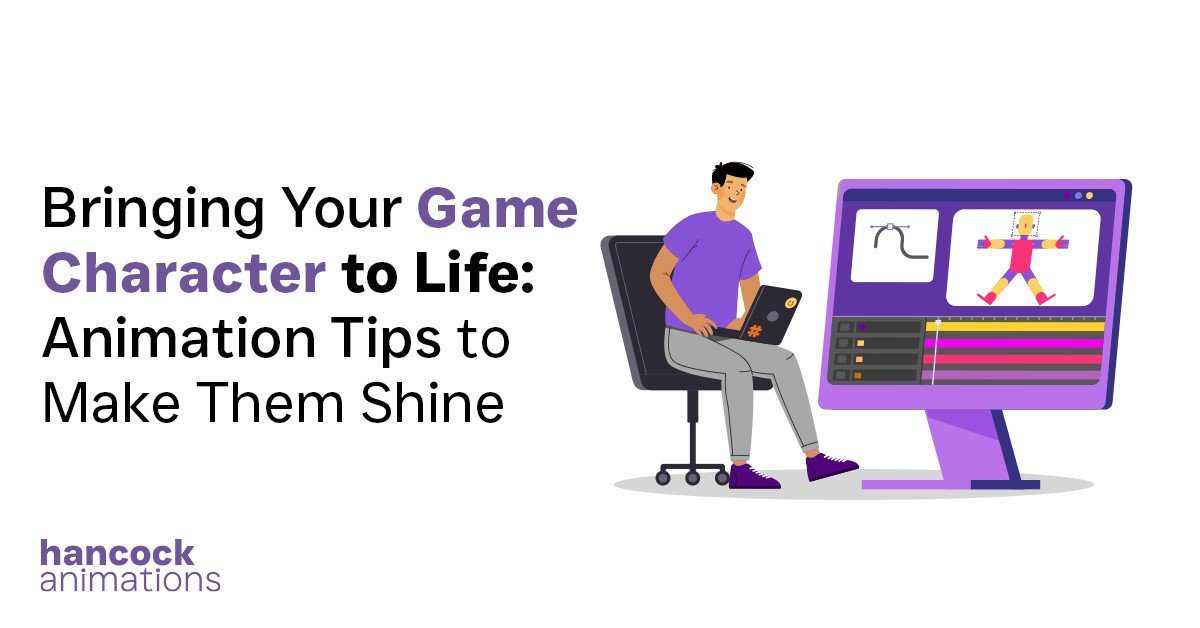Bringing Your Game Character to Life: Animation Tips to Make Them Shine

Bringing Your Game Character to Life: Animation Tips to Make Them Shine
We’ve all encountered them – those video game characters that leave a lasting impression.
From Mario’s infectious enthusiasm to Nathan Drake’s effortless swagger, these digital beings transcend pixels and become pop culture icons.
But what makes them stand out?
How do animators breathe life into these characters and make them truly unforgettable?
Well, fret no more, fellow game enthusiasts and aspiring animators!
Today, we’re diving into game animation, exploring key techniques that can elevate your character from good to great.
So, grab your virtual drawing pad, crank up the creativity, and let’s get animating!
The Power of Personality: The Heart of Your Character
Before we delve into technical aspects, let’s address the core. A truly captivating character needs a strong personality.
Would Mario be as beloved without his constant “Mamma Mia!” and enthusiastic jumps? Probably not.
So, the first step is to define your character’s personality clearly.
Are they a stoic warrior, a witty rogue, or a goofy goofball?
Fleshing out their background, motivations, and quirks will guide your animation choices later.
Here are some brainstorming questions to get you started:
- What are their core values? What drives them?
- What are their strengths and weaknesses?
- Do they have any unique mannerisms or habits?
- How do they react to different situations (victory, defeat, surprise)?
By answering these questions, you create a foundation that will inform every movement your character makes.
Acting for Pixels: Borrowing from the Big Screen
Do you think animation is all about making things move? Think again! Animators borrow heavily from traditional acting techniques.
Just like actors embody a character, animators use animation principles to showcase emotions and personality through movement.
Here are some key principles to remember:
- Squash and Stretch: Exaggerate movements to emphasize actions and emotions. A triumphant jump can be “squashed” at its peak for emphasis.
- Anticipation: Build anticipation for an action. A character preparing to punch might pull their first back before unleashing it.
- Follow Through: Movements don’t stop abruptly. A character running might have their body lean forward even after their foot comes down.
- Staging and Posing: Frame your character’s actions clearly. A confident stance with arms crossed can convey a different message than hunched shoulders and averted eyes.
By mastering these principles, you can give your character a natural flow and expressiveness that makes them feel more alive.
Mastering the Body Language: It’s All in the Details
Speaking of expressiveness, let’s discuss body language. We communicate a lot through subtle movements—a raised eyebrow, a crossed arm, a hesitant step.
The same goes for game characters!
- Idle Animations: Even when seemingly “standing still,” your character shouldn’t be a statue. Subtle idle animations like weight shifting, adjusting clothing, or looking around can add life and personality.
- Reactions: How does your character react to the environment? Do they shiver in the cold or squint in bright sunlight? Tiny details like these breathe life into the world, making your character feel grounded.
- Movement Speed and Weight: A hulking warrior will move differently than a nimble thief. Consider the weight and size of your character when animating their movements.
Let’s Talk Walk Cycles: The Unsung Hero of Animation
The walk cycle might sound mundane, but it’s the foundation for most in-game movement.
A well-crafted walk cycle can instantly tell you a lot about a character – their personality, physical attributes, and emotional state.
Here are some things to keep in mind:
- Balance and Rhythm: A good walk cycle should be balanced and have a natural rhythm. Imagine a bouncing ball – the weight of the character should shift from one foot to the other in a smooth arc.
- Speed and Stride Length: Is your character a speedy sprinter or a slow, methodical walker? Adjust the stride length and speed to match their personality and movement style.
- Pose Variety: Slight variations in the walk cycle can add realism and prevent it from looking robotic. For example, the character might swing their arms slightly differently on each step.
Teamwork Makes the Dream Work: Collaboration is Key
- 3D Modeling and Rigging: The 3D modelers create the digital representation of your character, while the riggers set up the “bones” that allow for animation. A good working relationship with these teams ensures your animations translate smoothly onto the character model.
- Sound Design and Voice Acting: The right sound effects and voice acting can elevate your animations to a whole new level. Imagine Mario’s iconic “Wahoo!” without the sound design!
Through open communication and collaboration, your character can evolve from a concept sketch to a fully realized, engaging being within the game world.
Animation Tools and Resources: Tech Power for Creativity
The world of game animation offers a plethora of tools to help you create magic. Here are some resources to consider:
- 3D Animation Software: Tools like Maya, Blender, and 3ds Max are industry standards for creating and animating 3D characters.
- Motion Capture Technology: Mocap allows you to record real-life movements and translate them onto your character. While expensive, it can add a layer of realism to your animations.
- Online Tutorials and Courses: Many online resources are available for aspiring animators. From free YouTube tutorials to in-depth paid courses, you can find something to suit your learning style and budget.
Practice Makes Perfect: Hone Your Skills and Learn from Others
Animation is a skill that takes time and dedication to master. The good news? The more you practice, the better you’ll become. Here are some tips to accelerate your learning:
- Start with Simple Animations: Don’t create complex movements immediately. Focus on mastering basic principles like walk cycles and idle animations before moving on to more advanced techniques.
- Study the Masters: Watch animation from your favorite games and movies. Pay attention to how characters move and express themselves. Identify what makes their animation stand out.
- Get Feedback and Iterate: Share your work with other animators or online communities and get feedback. Use their suggestions to refine your animation and push yourself to improve.
Animation is Storytelling: Let Your Character Shine Through Movement
Remember, animation is a powerful storytelling tool. Every movement and twitch tell a part of your character’s story.
So, use animation to make your character move and to make them come alive, showcase their personality, and connect with the player emotionally.
Beyond the Basics: Advanced Techniques to Elevate Your Animations
Once you’ve mastered the core principles, you can delve into more advanced techniques to truly make your character animations shine:
- Lip Syncing: Bringing your character’s voice acting to life visually is crucial for immersion. Various approaches to lip-syncing exist, from hand-animated to automatic tools. Mastering lip-syncing can significantly enhance the emotional impact of your character’s dialogue.
- Facial Expressions: The human face is a powerful tool for communication. Learn how to use subtle facial expressions like eyebrow raises, smirks, and furrowed brows to convey a wide range of emotions in your character.
- Weight Shifting and Anticipation: Take your walk cycles and other movements a step further by incorporating weight shifting and anticipation. A character preparing to throw a punch might shift their weight back slightly before lunging forward. These details add a layer of realism and intentionality to your animations.
- Secondary Animations: These subtle background movements add depth and believability to your character. For example, hair swaying in the wind, clothing rippling as they walk, or taking a deep breath before speaking can all add a layer of polish.
- Emotional Impact: Animation isn’t just about making things move; it’s about evoking emotions in the player. Use animation principles like squash and stretch and character acting techniques to showcase your character’s emotional state, whether it’s joy, fear, or determination.
Breathing Life into the World: Environmental Storytelling
While your character is the star of the show, the environment they inhabit plays a crucial role in animation. Here’s how animation can enhance the world-building:
- Interactive Elements: Use animation to create interactive elements in the environment. A swinging vine, a flickering torch, or a rippling pool of water can all add a sense of life and encourage player interaction.
- Background Animations: Don’t let the background be static! Subtle animations like swaying trees, swirling dust particles, or flickering firelight can make the world feel more alive and dynamic.
- Transitions and Level Changes: Use animation to smooth transitions between environments, doors opening, or rising platforms. This can enhance the game’s overall flow and improve the player experience.
Animation for Different Game Genres: Tailoring Your Approach
The animation style and techniques you use will vary depending on the genre of your game. Here are some genre-specific considerations:
- Action Games: Focus on fast-paced, impactful animations that emphasize fluidity and combat prowess.
- Platformers: Prioritize precise and responsive jumps and movements. Players must feel confident in their character’s control.
- RPGs: Emphasize expressiveness and emotional depth in your animations. These characters will likely have a lot of dialogue and interaction with the player.
- Puzzle Games: Keep animations clear and concise to maintain a smooth gameplay experience.
Optimization is Key: Balancing Performance and Quality
Animations are beautiful, but they can also be resource-intensive. Balancing visual quality and smooth performance is crucial, especially for mobile games or games with limited processing power.
- Smart Use of Resources: Use fewer frames for subtle animations like blinking or breathing.
- LOD (Level of Detail): Consider implementing LOD systems that adjust the complexity of animations based on the distance from the player.
- Collaboration with Programmers: Work closely with programmers to ensure your animations integrate seamlessly with the game engine and maintain a good frame rate.
It’s a Marathon, not a Sprint: Building Your Animation Skills
Remember, mastering animation takes time and dedication. Don’t get discouraged if you don’t see results overnight. Here are some tips to stay motivated and keep improving:
- Set Realistic Goals: Break down your learning into smaller, achievable goals. Focus on mastering one technique at a time before moving on to the next.
- Find a Community: Connect with other aspiring animators online or in your local area. Sharing your work, getting feedback, and participating in discussions can be a great source of motivation and learning.
- Never Stop Learning: The animation industry is constantly evolving. Stay up-to-date on the latest trends, tools, and techniques by reading industry blogs, watching tutorials, and attending workshops.
Conclusion: From Pixels to Personalities – The Power of Animation
By following these tips and unleashing your creativity, you can create game characters that are not just visually appealing but truly memorable.
They’ll be the characters players root for, laugh with, and remember long after they’ve finished the game.
So, fire up your animation software, embrace the power of storytelling, and bring your pixelated personalities to life!
Bonus Tip: Don’t be afraid to experiment and have fun! Animation is an art form; the best characters often emerge from a place where creativity and explanation are first served. Here at Hancock Animations , we make sure it happens

